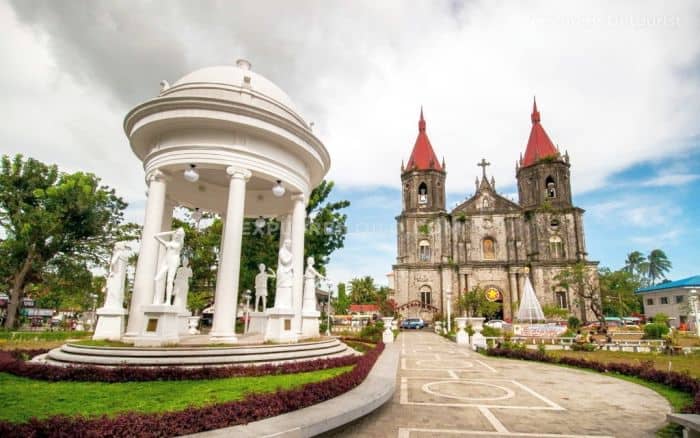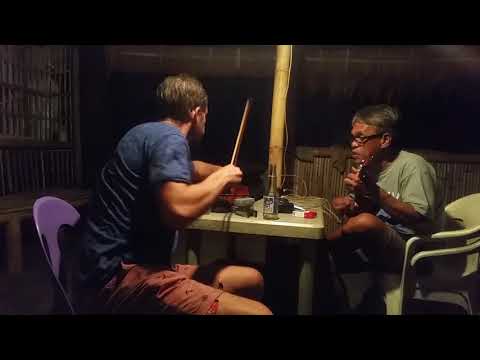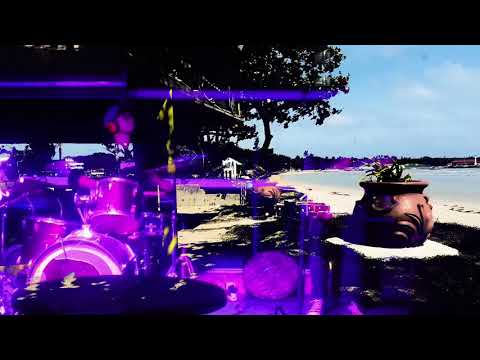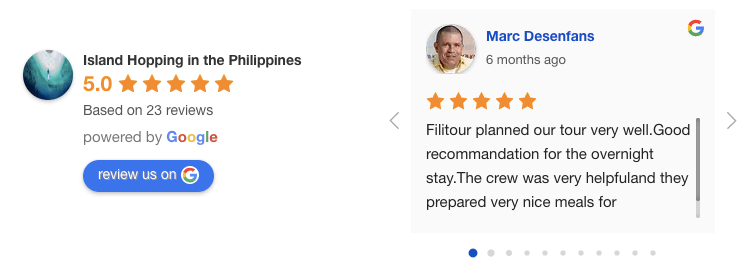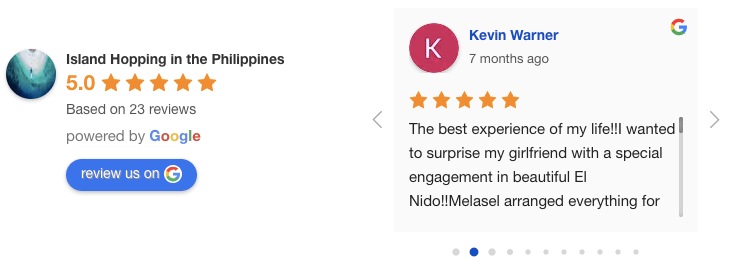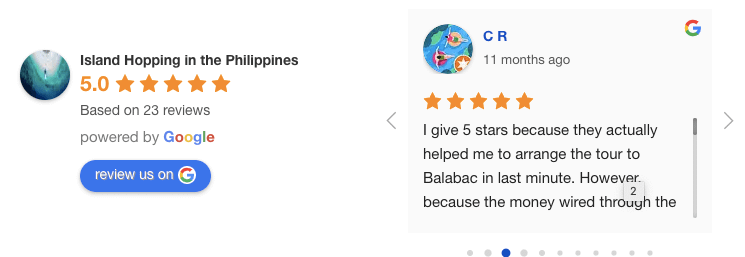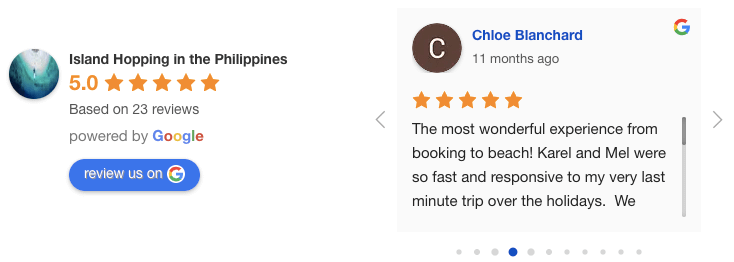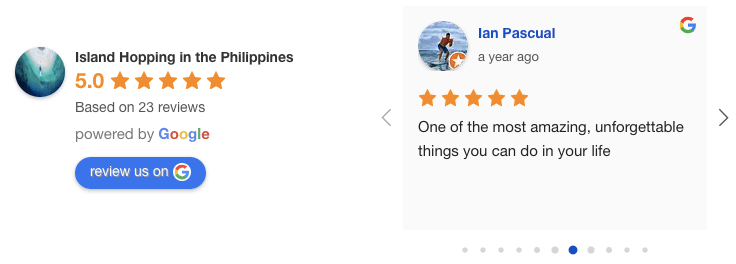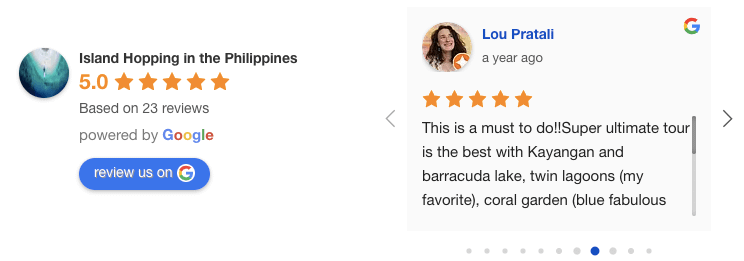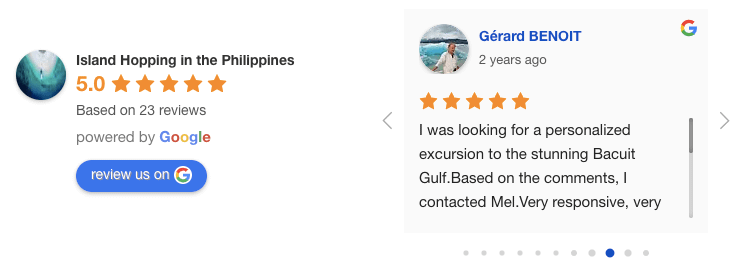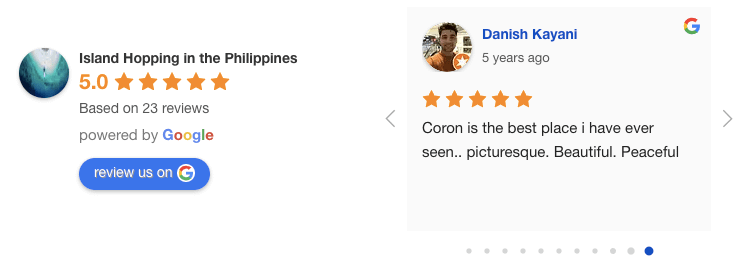
At 2.3 million in population, Iloilo City is the largest on the island of Panay, it has an airport, is easy to get to, and therefore a good launching pad if you’d like to explore the beautiful island of Panay. Guimaras Island is just to its south and another good tour destination.
Jump to:
It was my landing point when I started to explore the Visayas and I was rather looking forward, as I read that it is the fifth most livable city in the world according to Forbes magazine. But sorry, I don’t know what the author of that article was smoking, but this can be hardly possible. It’s just another Filipino crap town with practically no park or trees. Just another Asian jumble of one shop after another and miles of endless concrete.
But it does have some nice pockets, which I discovered over a six month period as I was making my preparations to explore the rest of the Philippines for this website. I’ll explore it in greater detail once I get my motorbike, but I have already traversed most of the city since I like to walk. Below you will find my favourite spots.

I’ve broken up the city into four parts:
- A – quiet beach resort area in the far west
- B – the area I lived in and a good stretch for restaurants and night entertainment on the beach
- C – the downtown core
- D – a good party, live music and shopping area
I’ll update this page once I get my bike and explore the rest, which I’m told is mostly suburbia but has some nice historical sites to see.
First the downtown area:

For the exact locations of these places you can download them from my maps.me page.
A – local neighbourhood party spot
As I explain on my Philippines tips page, my favourite way to explore cities is to use the maps.me app and just walk around randomly. In this neighbourhood I always had a great time, people sitting outside drinking Red Horse and inviting you to join them. On the weekends every third house would pull out their massive speakers and have stereo wars throughout the area, traffic walking back and forth.
Along the shore to the south, there is a long road which can also be somewhat fun, but it is a major car/jeepney traffic route, so it is louder, you will be inhaling all that, and it is more like a busy road rather than an urban neighbourhood to walk through safely. It is also policed more frequently and the locals are more afraid to drink on the street.
B – Jeproks

This place plays live music on Fridays and Saturdays and has a nice atmosphere to hang out. They have a grill outside to cook for you. More info.
C – St. Anne Church
Worth visiting if you’re into that thing.



D – Smallville and the Promenade
You can start at C, St. Anne’s church, and take the footbridge to the right of the main bridge to cross the river. On the footbridge you will often see fishermen with their poles dangling over the side and it already has a nice local feel to it.

Once you cross the bridge you will get to an area where you will find a little booth:



When they are open you can buy your tickets here. I’ll explain this in just a second.
Continue walking along the river promenade, closest you’ll get to a park here, but quite nice actually.



When I was there in August of 2018 they were building other sections of the promenade along both sides of the river. Hopefully they will be done by the time you get there. Nice stretch to stroll.
Soon you will get to the river tour place:

On my walks throughout the city, everywhere I crossed a bridge the river seemed quite clean, so it could be a nice ride. Will try to check it out before I split and update this page.
Keep walking east along the river promenade until you get to some buildings (not the first buildings you come across). You will find a passage through the buildings, where there is a Korean restaurant on the right. This whole area is Smallville, full of live entertainment and restaurants. Feel free to stroll around. Continue away from the river and you will get to my two bookmarks next to one another. These I found the best places for live music.
Bourbon street:


This is a nice section with lots of different restaurants, also up top on the balcony overlooking the venue below. They play live music from Thursday to Sunday, around 7pm to 2am, two bands each night.

It plays live music every night at about the same time, but has two stages: one outside on the ground floor and another on the first floor in the building behind it. At 2am the band stops in the building and it turns into a raging disco with live DJ.
E – SM City
If you’re into shopping and gargantuan malls, this is the place for you. It is right next to a major road marked orange on the map with a 5 on it. Once that crosses the river, from there you will find frequent jeepneys taking you right there – just look for SM City.
G – Masu Cafe

Oops, left out F. Anyway, caught my attention. Could be a good joint if you are a vegetarian. I like to have their chickpea soup/appetizer.
Around the corner is a place where you can get a full blood test for around $16.
H – Robinnson’s Mall
Another large mall, next to which is the city’s largest “wet market”, an outdoor market where you can get all sorts of stuff. Best to go early morning if you want the best selection. A fun tourist zoo, endless meandering isles. Outside on the rim is speckled with tons of little eateries for a good local experience and very inexpensive cooking.
I – Main Post Office and Gym

I often use the main post office, wherever I am, to send me stuff by ebay. At the bottom of those three bookmarks is a gym. In each city I like to stay at least a month, to give me time to properly explore the city and workout a bit. In this case they have karate and boxing classes, with a not-so-great weight room underneath. A better one is in another location explained below.
Sliding the map view to the left/west, we get to my hood:

A – Beach Resorts
I live around C and on Sundays I like to take a long walk to A, where there is a stretch of beach with a couple of resorts (more info below) and three venues where you can hang out by the beach. The middle one is quite stuffed with partying locals on the weekends.
B – Long quiet stretch and chess players
‘A’ is actually the next village and outside Iloilo City proper. The B stretch is open field and a nice, peaceful walk.


When it rains a lot, sometimes you need a plank of wood to get to your house.

Just another rooster farm.
Once you get into the A area and the next village, I find this another friendly place where locals will often invite you to join them for some drinks.
Somewhere around the bookmark just above B is a very small store where, every day from around noon till dark, locals like to play chess. I join them every Sunday. They have three boards and they actually play quite well!
C – Restaurant stretch and other things
If you continue walking towards the city you will come across many restaurants on the beach side. Some have live bands, no shortage of cheesy karaoke joints, lots of bamboo terraces built out over the beach.

Getting ready to roast a pig for one of the restaurants.


Walking further along you will eventually get to my favourite restaurant for Sundays:


It is very peaceful and the eating area is not built up on stilts like the other places, so you can actually sea the beach and you feel closer to it. But note that their menu is very limited, but you cannot go wrong with some simple rice and fish stuffed with vegetables cooked on a fire grill!
A little bit past this joint, closer to the city, is the famous Tatoy’s restaurant, which also has two swimming pools in case your resort does not.
Keep walking towards the city center and you will eventually arrive at the place I was staying – Villa Varona. Very friendly guy, a nice quiet stretch on the beach. I will update his accommodation below once he finishes preparing it, as I was helping him with that. It is right next to Yulo Drive. If you walk north along that you will find Arthur’s Villas on the left hand side, where you can find cheap and safe accommodation. Keep walking north away from the beach, past the 711, until the very end, take a left, and above the Oyster Seafood restaurant you will find a good gym weight room open from 7am-10 and 4pm-9.

Or instead of turning left on Yulo Drive, keep walking straight along the beach. There are many little resorts, but most of them have hourly rates because there are a lot of prostitutes in this area at night. Although I have always felt completely safe and met friendly people happy to just chat.
Travel Package Tour
Easy enough to explore on your own, but if you’d like some help navigating, or see some of the many sites accessible by single day trips from Iloilo, such as on the islands of Panay, Negros or Guimaras…
Road Trip
This is where I bought my motorbike with sidecar and started my exploration of the Philippines, so for this particular map I have not yet set up the GPS tracker but have drawn the maps manually.

According to the Accommodation info below, I was staying at one of the resorts along the beaches, so my roadtrip started from around there, at the bottom left of the above map.
A nice little shortcut off the main road, then back onto it, relatively low traffic and nice to avoid the center this way, eventually to the green dots area, map immediately below.

- A: is where I parked my bike at a couple of nice churches and monuments.
- B: I then walked to B, which is Nelly’s Garden Landmark (picture and explanation below).
- C: I then walked back to C, but could not find this Casa Mariquit. Walked around the block and did find a nice old building worth checking out.
- D: Then up to the Angelicum School, entrance directly off to the left from the busy street.
As always all my red star bookmarks can be downloaded from my maps.me page.
Going up further along that road there are two more tourist attraction red stars according to TripAdvisor: Jarod Cathedral and Sanson y Montinolo Antillan Ancestral House. I asked some locals and could not find either, but you can book a tour guide through us if you like.
I parked my bike in front of this church in the square at point A:

This church was across the street:


Some buildings I came across while walking to B:


Nelly’s Garden, 100p entrance, can only take pictures outside and cannot go into the building:








Walking back and up to C, I walked around the block back to the square and came across these buildings:


Now I drove to point D, also can only remain outside, donations voluntary:






The last star is near Quintin Salas street, which you would take left and continue along this map:

A nice quiet country road which takes you straight to the first green dot, another popular site according to TripAdvisor, in the town of Santa Barbara:




Decided to take a little beer and snack break in this little place at the corner of the square next to 711:

Then continue on to the next green dot, Cabatuan:




After which I wandered my way back to the coast, sometimes missing my turn and ending high up in the mountains:




And came across this church once I hit the coast:

Then a drive back along the coast, but first a pitstop with the usual gang for a friendly game of chess. All in all a perfect Sunday!
Accommodation
You will find lots of nice affordable places on airbnb, for example, but the first one I tried, on the edge of town, when I first arrived, was very nice with a very nice host, but hell in terms of the constant barking and rooster bothering me in my open space. So be careful of something like this if staying longer term.
Because I had some friends visiting and they wanted to stay near me, I have picked out the following places right on the beach, which I find quite important if you are going this far for a vacation. There are other places on the other side of the road from the beach which you can check out yourself.
Starting from the far west on the outskirts of town and working our way towards the center.
Adhara Boutique Resort



Entrance into the area past big iron gate and 24/7 security guard.



Padi Beach Resort

No internet presence, just call Joemarie, 1,500p/night @ 0955 723 7945. They are building four huts which should be ready by February.

The four huts they are building in the back of the property. Very quiet and peaceful.

View of the beach area with lounge huts.
Villa Azul Beach Resort

Villa Azul – tel. 0917 597 3216, I believe 700p/night

A bit off to the side in the back of the property, no security fence.

A view of this resort looking west from the beach. The beginning of three sets of establishments (the middle one gets busy with locals on the weekends but has no sleeping accommodation – the two on either side are quiet and peaceful).

View of the beach looking eastward from same position as above. Fishermen community, small village.
Villa Rosa by the sea Beach Resort

Villa Rosa – this is on the other/east side of me, closer to the center. In this section a lot of resorts offer per hour rates, obviously in the service of prostitutes, but I did find two resorts which do not cater to that, have good iron gate security, and are peaceful and quiet. I’ve walked along the busy street at night many times and was never hassled, but a fragile family with youngsters might find themselves feeling uncomfortable. Not a problem for the management to call a taxi for you if you are afraid of going out on the street at night.






Iloilo Paraw Beach Resort

Iloilo Paraw, or their website – closer to the centre. 600/night for aircon and 400 for fan. They host a lot of conference and other events for locals. They also have two swimming pools, which you can use for a modest fee if not staying at their resort.




History of Iloilo City
 The island of Panay was originally inhabited by the Negritos (or Atis) and the Visayans. The Negritos were a nomadic type of people living in the mountains, were half-naked and wore a piece of bark to cover their private parts. They were hunter gatherers and roamed around looking for food.
The island of Panay was originally inhabited by the Negritos (or Atis) and the Visayans. The Negritos were a nomadic type of people living in the mountains, were half-naked and wore a piece of bark to cover their private parts. They were hunter gatherers and roamed around looking for food.
The Visayans, on the other hand, lived along the coasts and rivers. They adorned their bodies with tattoos, like other tribes in the Visayas, and wore cotton clothing with coloured stripes, silk, and cloth made from banana leaves.
 In the 13th century Malaysia and Indonesia were ruled by the Hindu-Malay Empire, while a cruel sultan ruled Borneo. Ten of his ruling subordinates decided to escape and one dark night left the island with their families, warriors, slaves and supplies. Sailing north in no particular direction for many days, they finally reached the southern shores of Panay island. Actually, Panay might be named after the kingdom of Pannai, located in Sumatra, whereby the i and y letters are considered interchangeable to the later colonising Spanish.
In the 13th century Malaysia and Indonesia were ruled by the Hindu-Malay Empire, while a cruel sultan ruled Borneo. Ten of his ruling subordinates decided to escape and one dark night left the island with their families, warriors, slaves and supplies. Sailing north in no particular direction for many days, they finally reached the southern shores of Panay island. Actually, Panay might be named after the kingdom of Pannai, located in Sumatra, whereby the i and y letters are considered interchangeable to the later colonising Spanish.
The Borneans landed at the mouth of the Sirwagan River, near the present town of San Joaquin in Iloilo, and then proceeded up the river to Lake Andona, where they met a local fisherman. The fisherman escorted the ensemble to a local king and queen, where the Borneans extended their hands in friendship and worked out a trade in exchange for land, offering the king a gold helmet and his wife a long gold necklace. The locals were content with the pact and conceded the low lying flatlands, moving up into the mountains.
The Borneans wasted no time and soon built up an empire in the fertile flatlands, building up a powerful and strong naval force that rivaled the nearby states of Cebu and even the Sultanate of Sulu in terms of prestige and wealth. By the 14th century the state had grown so powerful militarily and economically that their naval force was in constant threat against Chinese Imperial shipping by their devastating raids. As one Friar later commented: “…in the ancient times, there was a trading center and a court of the most illustrious nobility in the whole island.”

This rule saw a period of prosperous peace for 300 years, until the Spanish made their debut. When they arrived they noted that the pirates among them were more terrifying than the Mohammedans of Jolo and Mindanao. Like the other fierce tribes in the Visayas, after every harvest they would sail to faraway places in a hunt for slaves, making raids on settlements wherever they went.
The Spanish settlement on the southern banks of Panay island were their second colonial outpost in the area, when a Spanish conquistador moved his headquarters from the island of Cebu in 1566 to the town of Ogtong (Oton). However, due to frequent attacks by Muslim pirates (the Moros) and Dutch and English privateers, in 1581 the Spanish moved to safer havens to Arevalo. But this was still not safe enough, so in 1700 they moved 25km eastward to the village of Irong-Irong, which was endowed with a natural and strategic defense, building Fort San Pedro at the mouth of the river. Irong-Irong, otherwise known as Ilong-Ilong, was shortened to Iloilo and its natural port quickly became the capital of the province. Irong actually means “nose”, where the town was built on a tongue of land sticking out south of Iloilo River and shaped like a nose.

Iloilo continued to prosper under Spanish rule, by 1855 becoming the largest port in the Philippines, open to world trade and the premier province of the country due to its various economic activities. Such as the lucrative sugar industry (grown mostly in neighbouring Negros but exported through Iloilo), followed in the late 18th century by a large-scale weaving industry, the city then referred to as the Textile Capital of the Philippines, its products exported to Manila and abroad.
But prosperous as it might have been under the Spanish, rebellion against rule was fomenting in Manila, while Iloilo remained loyal to the Spanish crown in spite of the Tagolog uprisings. The rest of Panay and Negros expressed their support, emboldening the Ilongo (local tribe of Iloilo) elite to form a battalion of 500 native volunteers, who with the help of Spanish and foreign communities in the area, went up to Manila to quell the Tagalog revolt.
 Such devotion earned Iloilo the title “La Muy Leal y Noble Ciudad” (Most Loyal and Noble City), later simplified to Queen’s City in the South. But its status was soon to be elevated further, becoming the capital of the Spanish East Indies after the Spanish were thrown out of Manila in their war against the United States. A truce was agreed upon until an agreement would be reached at the Treaty of Paris in 1898, but Tagolog forces headed south to stir up rebellion in the hopes that it will affect the outcome of the treaty.
Such devotion earned Iloilo the title “La Muy Leal y Noble Ciudad” (Most Loyal and Noble City), later simplified to Queen’s City in the South. But its status was soon to be elevated further, becoming the capital of the Spanish East Indies after the Spanish were thrown out of Manila in their war against the United States. A truce was agreed upon until an agreement would be reached at the Treaty of Paris in 1898, but Tagolog forces headed south to stir up rebellion in the hopes that it will affect the outcome of the treaty.
And it worked, for by the date of the treaty the rebel forces had secured the entire island of Panay with the exception of Iloilo City proper. The Spanish officially surrendered their claims, but the independence of the Ilongo was shortlived as the Americans soon headed south with 3,000 troops and two ships to claim what the Paris treaty had awarded them.
First the Americans enforced their claim in Manila, after which message was sent to the Panay rebels to resist takeover. The natives numbered about half of the invaders, and who were further insolent and unruly because, although they were promised food and monthly remuneration of 4 pesos, they only received one. In face of possible mutiny, the generals scrambled by collecting funds from surrounding towns to support the troops.
The Americans started bombing the city, and destroyed many buildings, but as the rebels retreated, in light of being short changed in wages and jealous of the rich merchants and Spanish half-castes, they burned their way during their exodus of the city, while two British warships sent marines ashore in a gallant effort to protect foreign property, since the UK maintained strong business interests in the area and a consulate. Unfortunately, the gallant effort was insufficient and the main part of the Queen City was reduced to ashes.

By February of 1899 the Americans began to take measures to formally colonise the island, but they continued to meet resistance through to 1901, Iloilo City becoming one of the last to fall to the new rule. As many of the leaders surrendered to the new regime, the Americans quickly reintegrated them back into power, one general becoming the island’s governor to receive the highest pay in the country of all governors at $3,000 in gold annually. As such, Iloilo became the last capital of the Spanish Empire in Asia and the Pacific.
Eventually World War II came around when the Japanese initiated their occupation of the country in 1942. But the Panay Guerilla Movement was the first resistance group in the country, continued fighting the Japanese until the American liberation in 1946.

Now Iloilo is referred to as the “Heart of the Philippines” and “(Asia’s) City of Love”, because of Iloilo and Panay Island’s central location in the Philippines and the soft and gentle spoken Ilonggo people. With its strong Spanish roots, the city has become an “Emerging Museum City of the Philippines” and “City of Mansions”, clustered with heritage structures and mansions that were built during the Spanish and American colonial eras.
| Where to go next | |||
|---|---|---|---|
| Clockwise | Counter clockwise | ||
 |
Iloilo City | San Antonio de Padua Church |  |
| Guimaras Island or Bacolod | |||
 |
|||
Explore Panay
Explore Philippines
Our reviews:

Home » Visayas » caves »
We are a family operation managing private custom boat tours in the beautiful Palawan area, and are happy to help travelers with their plans through the country, having traveled a lot of it ourselves and planning to visit it all.
